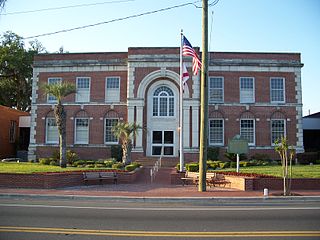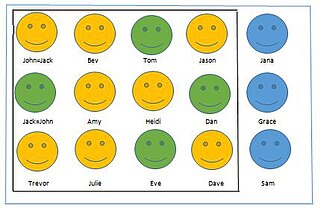Related Research Articles

The United States Census Bureau (USCB), officially the Bureau of the Census, is a principal agency of the U.S. Federal Statistical System, responsible for producing data about the American people and economy. The Census Bureau is part of the U.S. Department of Commerce and its director is appointed by the President of the United States.

Broward County is a county in the southeastern part of Florida, located in the Miami metropolitan area. It is Florida's second-most populous county after Miami-Dade County and the 17th-most populous in the United States, with 1,944,375 residents as of the 2020 census. Its county seat and most populous city is Fort Lauderdale, which had a population of 182,760 as of 2020.

Union County is a county located in the north central portion of the U.S. state of Florida, the smallest in the state by area. As of the 2020 census, the population was 16,147. The county seat is Lake Butler. With a personal per capita income of $18,396, it is the poorest county in the United States.

Kings County is a county located in the U.S. state of California. The population was 152,486 at the 2020 census. The county seat is Hanford.

Mariposa County is a county located in the U.S. state of California. As of the 2020 U.S. Census, the population was 17,131. The county seat is Mariposa. It is located in the western foothills of the Sierra Nevada mountains, north of Fresno, east of Merced, and southeast of Stockton.

West Athens is a census-designated place (CDP) in Los Angeles County, California. The population was 9,393 at the 2020 census. It is an unincorporated community within the 2nd Supervisorial District of Los Angeles County. West Athens is served by the Los Angeles County Sheriff's Department, operating out of the South Los Angeles Station. The approximate boundaries for West Athens are: 87th Street to the north, Vermont Avenue to the east, El Segundo Boulevard to the south, and approximately Western Avenue to Van Ness Avenue to the west. West Athens is predominantly residential, with commercial uses along its main corridors. Los Angeles Southwest Community College lies within the West Athens neighborhood and city limits.
In the United States census, the U.S. Census Bureau and the Office of Management and Budget define a set of self-identified categories of race and ethnicity chosen by residents, with which they most closely identify. Residents can indicate their origins alongside their race, and are asked specifically whether they are of Hispanic or Latino origin in a separate question.

The 2000 United States census, conducted by the Census Bureau, determined the resident population of the United States on April 1, 2000, to be 281,421,906, an increase of 13.2 percent over the 248,709,873 people enumerated during the 1990 census. This was the twenty-second federal census and was at the time the largest civilly administered peacetime effort in the United States.

The United States census is a census that is legally mandated by the Constitution of the United States. It takes place every ten years. The first census after the American Revolution was taken in 1790 under Secretary of State Thomas Jefferson. There have been 23 federal censuses since that time. The census includes territories of the United States. The United States Census Bureau is responsible for conducting the census.

The American Community Survey (ACS) is an annual demographics survey program conducted by the U.S. Census Bureau. It regularly gathers information previously contained only in the long form of the decennial census, including ancestry, US citizenship status, educational attainment, income, language proficiency, migration, disability, employment, and housing characteristics. These data are used by many public-sector, private-sector, and not-for-profit stakeholders to allocate funding, track shifting demographics, plan for emergencies, and learn about local communities.

The 2010 United States census was the 23rd United States census. National Census Day, the reference day used for the census, was April 1, 2010. The census was taken via mail-in citizen self-reporting, with enumerators serving to spot-check randomly selected neighborhoods and communities. As part of a drive to increase the count's accuracy, 635,000 temporary enumerators were hired. The population of the United States was counted as 308,745,538, a 9.7% increase from the 2000 United States Census. This was the first census in which all states recorded a population of over 500,000 people as well as the first in which all 100 largest cities recorded populations of over 200,000.

The 1870 United States census was the ninth United States census. It was conducted by the Census Office from June 1, 1870, to August 23, 1871. The 1870 census was the first census to provide detailed information on the African American population, only five years after the culmination of the Civil War when slaves were granted freedom. The total population was 38,925,598 with a resident population of 38,558,371 individuals, a 22.6% increase from 1860.

The South Dakota Highway Patrol is the state police agency for South Dakota, which has jurisdiction everywhere in the state except for sovereign Native American reservations. It was created to protect the lives, property and constitutional rights of people in South Dakota. In addition to enforcement of laws, the SDHP has regional SWAT teams that provide tactical and warrant services to police and Sheriff Departments. The SDHP is also responsible for training K-9 teams to law enforcement agencies in South Dakota. The SDHP also has a division responsible for executive protection of the state dignitaries and protection of the capital grounds and administrative state buildings and grounds.

The Massachusetts Department of Correction is the government agency responsible for operating the prison system of the Commonwealth of Massachusetts in the United States. The Massachusetts Department of Correction is responsible for the custody of about 8,292 prisoners throughout 16 correctional facilities and is the 5th largest state agency in the state of Massachusetts, employing over 4,800 people. The Massachusetts Department of Correction also has a fugitive apprehension unit, a gang intelligence unit, a K9 Unit, a Special Reaction Team (SRT), and a Tactical Response Team (TRT). Both of these tactical units are highly trained and are paramilitary in nature. The agency is headquartered in Milford, Massachusetts and currently headed by Commissioner Carol Mici.

Massachusetts has an estimated population of 6.981 million as of 2022 according to the U.S. Census Bureau. This represents a −0.7% decrease in population from the 2020 census, when the population was 7.029 million. Currently, Massachusetts is the sixteenth most populous U.S. state.

The 2020 United States census was the 24th decennial United States census. Census Day, the reference day used for the census, was April 1, 2020. Other than a pilot study during the 2000 census, this was the first U.S. census to offer options to respond online or by phone, in addition to the paper response form used for previous censuses.

Coverage error is a type of non-sampling error that occurs when there is not a one-to-one correspondence between the target population and the sampling frame from which a sample is drawn. This can bias estimates calculated using survey data. For example, a researcher may wish to study the opinions of registered voters by calling residences listed in a telephone directory. Undercoverage may occur if not all voters are listed in the phone directory. Overcoverage could occur if some voters have more than one listed phone number. Bias could also occur if some phone numbers listed in the directory do not belong to registered voters. In this example, undercoverage, overcoverage, and bias due to inclusion of unregistered voters in the sampling frame are examples of coverage error.
The 2016 Australian census was the 17th national population census held in Australia. The census was officially conducted with effect on Tuesday, 9 August 2016. The total population of the Commonwealth of Australia was counted as 23,401,892 – an increase of 8.8 per cent or 1,894,175 people over the 2011 census. Norfolk Island joined the census for the first time in 2016, adding 1,748 to the population.
Department of Commerce v. New York, No. 18–966, 588 U.S. ___ (2019), was a case decided by the Supreme Court of the United States dealing with the 2020 United States Census. The case concerned the decision of the United States Census Bureau under the Trump administration to include a question asking whether respondents are United States citizens or not, on the standard census questionnaire sent to all households. That question had been purposely omitted from this "short form" since the 1950 Census because officials and sociologists thought it would reduce participation in the census. It has been used on the "long form" American Community Survey sent to a subset of households and used for statistical estimation.
References
- ↑ http://2010.census.gov/partners/national-complete-count-committee/ Archived 2009-12-14 at the Wayback Machine Complete Count Committee: US Census Bureau
- ↑ https://www.census.gov/prod/www/abs/FY07DisFedFund2009-06.pdf US Census Bureau: Uses of Population and Income Statistics in Federal Funds Distribution With a Focus on Census Bureau Data
- ↑ http://www.csus.edu/calst/Government_Affairs/reports/A_REVIEW_OF_THE_CENSUS_UNDERCOUNT_ISSUE.pdf Archived 2009-04-11 at the Wayback Machine California State University Sacramento: A Review of the Undercount Issue
- ↑ http://governor.ca.gov/state/govsite/gov_htmldisplay.jsp?BV_SessionID=@@@@0901921270.1256053714@@@@&BV_EngineID=ccccadeiefghemhcfngcfkmdffidfnf.0&iOID=9476&sTitle=Executive+Order+D-11-99&sFilePath=/govsite/executive_orders/d1199.html&sCatTitle=Previous+Administration%2FExec+Order%5B%5D California Complete Count Executive Order: Governor's Office
- ↑ http://info.sen.ca.gov/pub/99-00/bill/sen/sb_0701-0750/sb_711_bill_19990712_chaptered.pdf%5B%5D California State Senate: Senate Bill 711
- ↑ Stout, David (April 5, 2000). "Census Takers Uneasy as Mail Response Lags". The New York Times. ISSN 0362-4331 . Retrieved July 29, 2022.
- ↑ "Governor Newsom Issues Executive Order". California Governor. February 22, 2019. Retrieved July 29, 2022.
- ↑ http://lals.ucsc.edu/conference/papers/English/Kissman&JacobsEnglish.doc Archived 2010-06-27 at the Wayback Machine UC Santa Cruz: Practical Research Strategies for Mexican Indigenous Communities in California Seeking to Assert Their Own Identity
- ↑ http://thecensusproject.org/factsheets/CP-HTC-County-Number-4-20-09.pdf Archived 2010-07-18 at the Wayback Machine 50 Counties with the Largest Number of People Living in Hard-to-Count Areas
- ↑ http://thecensusproject.org/factsheets/CP-HTC-States-Number-4-20-09.pdf Archived 2010-07-18 at the Wayback Machine States Ranked by Number of People in State Living in Hard-to-Count Areas
